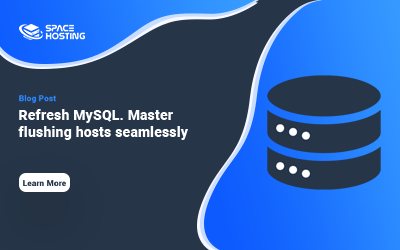Learn the importance «FLUSH HOSTS» command in MySQL and the method of how to flush hosts in MySQL. This guide provides a comprehensive understanding of the process, walking you through when to use it, its implications, and detailed steps to execute the command successfully. Get to grips with optimizing your MySQL database performance and secure your connections efficiently.
Table of contents
- Introduction
- What is «FLUSH HOSTS» in MySQL?
- Why You Might Need to Flush Hosts in MySQL?
- Understanding the MySQL Flush Hosts Command
- How to Flush Hosts in MySQL?
- Conclusion
Introduction
Every database administrator knows that maintaining the optimal performance and security of a MySQL server is crucial. At times, an excess of connection attempts from a host can cause the max_connect_errors parameter to be exceeded, which blocks subsequent connections. Here’s where «FLUSH HOSTS» comes into the picture. This MySQL command is essential for clearing the host cache, which, in turn, enables blocked hosts to make connections again.
This introductory guide aims to unpack the concept and usage of «FLUSH HOSTS» in MySQL, delving into the technicalities and offering clear, step-by-step instructions.
Regardless if you’re a seasoned MySQL user or just a beginner venturing into the database management realm, acquiring an understanding of this command is undeniably advantageous. Essentially, it serves as a potent tool in efficiently managing your MySQL server, paving the way for smoother operations and less downtime.
What is «FLUSH HOSTS» in MySQL?
The «FLUSH HOSTS» command is a MySQL statement that clears the host cache tables. The client connects to the MySQL server, host cache is checked. If not known, the server tries hostname resolution.
In a scenario where these connection attempts surpass the value set for max_connect_errors from a particular host, all without making a successful connection, MySQL naturally assumes there’s an issue and subsequently blocks the host from further connections.
At this juncture, the «FLUSH HOSTS» command comes into play. It permits you to wipe the slate clean of the list of blocked hosts, thereby effectively resetting the system. In effect, this action allows connections that were previously blocked to make another attempt at reconnecting.
Without a doubt, this command is critical in not only maintaining the robustness but also the efficiency of a MySQL database server.
Why You Might Need to Flush Hosts in MySQL?
There are many scenarios where you may need to flush hosts in MySQL. Primarily, it’s required when a host reaches its maximum number of connections. Similar to hosting services managing hosting accounts, MySQL maintains connections from hosts. Just like a web hosting company might limit account logins, MySQL sets a cap on connections. When a host hits this cap, it gets blocked. You must flush hosts to reset this. Hosting solutions providers often encounter such issues. When multiple users are operating on VPS or dedicated servers i.e. 5950X Dedicated Server, hitting the max connection limit is common. Therefore, knowing how to flush hosts is critical. It’s comparable to a hosting business managing traffic to ensure their dedicated server or virtual private server performance doesn’t suffer. So, understanding how to flush hosts is as crucial as knowing how to handle a hosting reseller program or managing gaming hosting, where connection handling is key.
Understanding the MySQL Flush Hosts Command
The MySQL ‘Flush Hosts’ command is an operational tool. Think of it as the control panel of a hosting solution, managing MySQL connections. When a host exceeds permitted connections, MySQL blocks it. Using ‘Flush Hosts’ is like restarting your control panel to accept new connections. In dedicated servers, you must manage many hosting accounts. If these connections exceed limits, the ‘Flush Hosts’ command is your go-to. The same applies to virtual private servers or even game server hosting. If you’re hosting a game server and it becomes overwhelmed, ‘Flush Hosts’ could help. Similar to game server hosting, in a hosting business too, you might need to unblock the connections by flushing hosts. It’s a command that could even find its use in a reseller hosting environment, just like maintaining the sell dedicated or free game server hosting. Therefore, grasping the ‘Flush Hosts’ command is indispensable in managing a robust MySQL system.
How to Flush Hosts in MySQL?
Flushing hosts in MySQL is a straightforward process that involves executing a specific SQL command. Here are the step-by-step instructions:
Step no. 1 — Connect to MySQL Server
To execute commands, connect to MySQL using the command-line client:
mysql -u root -pReplace ‘root’ with your MySQL username. After executing this command, you will be prompted to enter your password.

Step no. 2 — Execute FLUSH HOSTS Command
Once you’re logged into your MySQL server, you can clear the host cache by running the «FLUSH HOSTS» command
FLUSH HOSTS;Make sure to end your command with a semicolon (;) as it’s necessary in SQL to signify the end of a command.

Step no. 3 — Check Command Execution
MySQL will not provide a response if the command was successful. To confirm that the ‘FLUSH HOSTS’ operation was successful, you can check the MySQL error log. If there’s no related error message, it means the command was successful.

Step no. 4 — Exit MySQL Server
After you’ve flushed the hosts, you can exit the MySQL server by simply typing:
exit
These steps should clear the host cache in MySQL, effectively resetting any host blocks due to repeated connection errors. Please make sure you have the necessary privileges in MySQL to execute the FLUSH command.
Conclusion
‘How to flush hosts in MySQL’ is an important query for many hosting businesses. When too many connections are made from a specific host, MySQL may block it. This is where the ‘flush hosts’ command comes in. It resets the status of all host connections, benefiting hosting solutions with multiple users.
A control panel, like cPanel or Plesk, often helps manage such commands. It’s handy, especially on dedicated servers with large databases. By executing the ‘flush hosts’ command, you can efficiently manage the connections and ensure smooth operation of your hosting services.
Managing hosting accounts involves understanding such commands. Hosting businesses often deal with this, especially those dealing with virtual private servers or dedicated server resellers. The ‘flush hosts’ command can play a crucial role in maintaining the service quality.
The value of the ‘flush hosts’ command extends to web hosting companies too. It helps in handling excessive connection requests, ensuring optimal service. The same applies to reseller hosting, where multiple sub-accounts are in play.
Even gaming hosting benefits from understanding ‘how to flush hosts in MySQL’. It’s crucial for managing game server hosting effectively. Whether you’re offering free game server hosting or paid game servers, the ‘flush hosts’ command can be a game-changer, maintaining seamless gameplay.




0 Комментариев